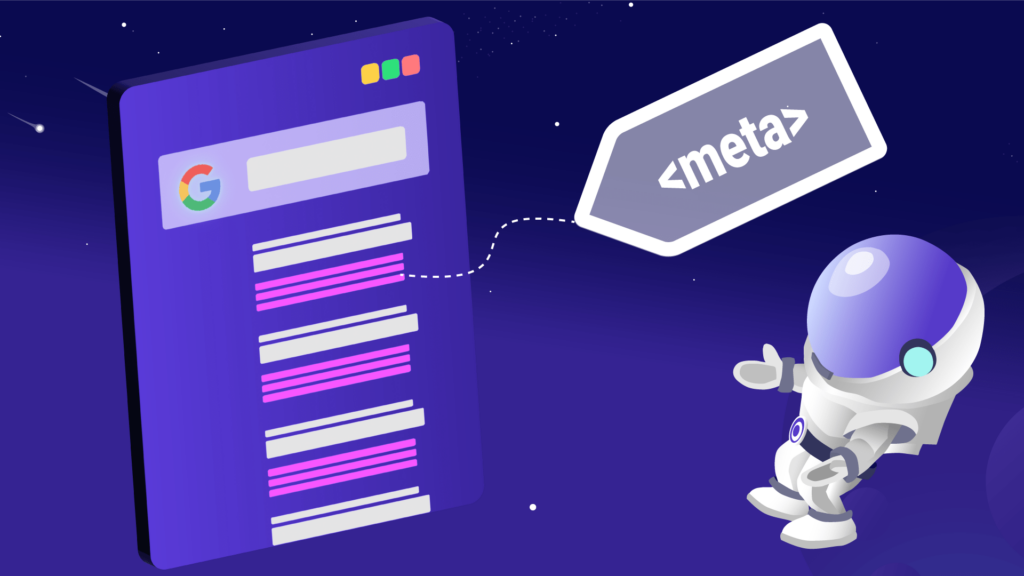In SEO we have a tendency to focus on how our pages rank, above all else. While page ranks is important, most people tend to think of it as the end goal of SEO, which couldn’t be further from the truth.
Once you actually get one of the coveted top spots on the Google search results page, you will actually need people to click on your articles. This is where your title tag and meta description comes into play.
While your title tag is also very important, it often tends to steal the spotlight away from meta descriptions, which is a shame. In this blog post, we will take a look at the different factors, that go into creating a great meta description. Read onwards if you want to learn how to create awesome meta descriptions, that capture both your users attentions and clicks, with our 9 easy to follow tips.
How do you write the perfect meta description?
Everyone can write a simple meta description but writing a great one is a challenge for many, to say the least. The perfect meta description abides by Google’s standards, features relevant information, and provides the user with a reason to click on your result.

Use these 9 tips to write great meta descriptions:
- Use your primary keyword in your meta description
- Avoid descriptions shorter than 120 characters
- Don’t include more than 160 characters
- Give the user a reason to click with a great CTA
- Write for the user and not the algorithm
- Match the user’s search intent to get the click
- Stand out from the competition with emojis
- Write an accurate explainer of your page
- Always write unique meta descriptions
Now let’s elaborate on these tips.
1. Use your primary keyword in your meta description
It is important to include your primary keyword in your meta description, because this is what the user is searching for and is interested in (if you haven’t already done a keyword analysis, you should use a keyword research tool, to make one before going any further). When you use your keyword in your meta description, Google will highlight it among all the other text every time a user searches for that word. This makes the keyword stand out, which immediately shows the user, that your result is relevant to what they searched for. As such, the chances to get their clicks increase.

2. Avoid descriptions shorter than 120 characters
You have roughly 920 pixels (or 160 characters) to put to good use, when making a meta description. Getting the most out of this space is a vital part, of making your users click on your page. Make sure to fill out the available space, in order to properly convey your value proposition, and show your users why they should click on your page specifically.
You should also try to avoid using abbreviations when it comes to your primary USPs (Unique Selling Points), as this can confuse users if they aren’t familiar with the terms. Avoiding abbreviations is, also a good way to avoid too short meta descriptions, which can be seen as sloppy, because they don’t showcase, what the user is about to find on your page.
3. Don’t include more than 160 characters
Now that we have talked about short meta descriptions, it’s important to note that too long meta descriptions aren’t great either. Long meta descriptions are automatically shortened by Google at the 920 pixels (around 160 characters) mark. This can result in your long meta descriptions miscommunicating your value proposition, if an important part of your USP is placed at the end of your meta description. This happens more often than you might think, especially since most Call-To-Action text is featured at the end of a coherent sentence.
If you want to make sure your meta descriptions have the right length, you can use a meta description checker, to check the length of all your meta descriptions at once.
4. Give the user a reason to click with a great CTA
By explaining the value of visiting your page and what you can concretely help with, you give the user a reason to click on your result instead of a competitor’s page. Using a Call-to-action is always great as it prompts the user to the next action you want them to take. For example, for transactional searchers where users want to buy something, you can directly communicate that you offer those products using a “Buy Here” CTA text. Similarly, for more informational searches, you can use a “Read More Here” CTA text.
5. Write for the user and not the algorithm
One of the most common traps in SEO, especially when it comes to text, is people directing their content towards the algorithm, rather than their users. While this is a bad way to create content in all forms of SEO, it’s especially bad when it comes to meta descriptions.
Even though meta descriptions are very important, they do not directly improve your SEO rankings on Google, so avoid the classic SEO mistake of optimizing them for Google. Instead, you should see your meta description as a promotional text that needs to convince the user that your solution to their problem is the best.

With that being said, it’s still important to note that your meta description has an indirect effect on your SEO, as people clicking on your page sends a positive signal to Google, which can improve your SEO rankings.
6. Match the user’s search intent to get the click
One of the all-time most important tips for your meta descriptions is to try to match the user’s search intent as closely as possible. The more relevant the user perceives your meta descriptions, the more likely they are to click on your page. Because of that, you need to find out what exactly the user expects to find when they search for those keywords.
For example, are they looking for an answer or a product they can buy? Figuring that out helps you avoid mistakes that can otherwise make your pages irrelevant. For instance, avoid using too salesy and promotional CTAs like “Buy Here” if the user is simply searching for information.
7. Attract your users with emojis
If you want to make your emojis stand out more, you can also use some emojis. Keep in mind, however, that not all emojis are shown. Using emojis will shine a spotlight on your page, and help you attract potential customers

While they add great contrast to the search results and can make your page stand out from all the rest, keep in mind that you shouldn’t overdo them. Using too many emojis can have the opposite effect as it can make your company seem unprofessional. Emojis can be a good idea to use in your meta descriptions but use no more than 2.
8. Write an accurate explainer of your page
A high Click-through rate is worth nothing if the users don’t stay on your pages. If you oversell your page or your landing page doesn’t live up to the expectations that you create in your meta description, this can be bad news.
In instances where the user doesn’t find what you promised them, they will leave as quickly as they enter. This can also have long-lasting effects. The user is less likely to return to your site since they associate it with negativity. Because of that, you need to ensure the contents of your meta description match the contents of the page as accurately as possible and aren’t simply “clickbait.”
9. Always write unique meta descriptions
You should always strive to write unique meta descriptions for each page. A generic meta description or CTA can be too bland or irrelevant for the user. In turn, such generic texts can result in lower click rates and fewer website visitors.
Final words
Thank you for reading. By now you should know a lot more about how to write meta descriptions for your pages, and why your meta descriptions matter. Meta descriptions entice customers to click on your pages, boosting your CTR, and giving you the possibility of acquiring new customers.
And with that I wish you good luck, with writing meta descriptions in your future SEO endeavours.
If you still want to know even more about meta descriptions, you can read our article, detailing what meta descriptions are and how they work. We have also answered some of the most commonly asked questions about meta description below:
How do meta descriptions directly impact SEO rankings?
Meta descriptions themselves do not directly influence SEO rankings as search engines primarily use them to understand page content and encourage click-throughs from search results. The real value lies in improving user engagement and CTR, which indirectly benefits SEO by signaling the content’s relevance and quality to search engines.
Can you provide industry examples where unique meta description strategies improved web traffic?
Specific industry examples aren’t provided in the article; however, ecommerce sites often see significant benefits from well-crafted meta descriptions. These descriptions can highlight deals, product uniqueness, and brand voice, directly impacting traffic and conversions by appealing to the targeted audience’s specific interests and needs.
How to measure the effectiveness of meta description changes?
To measure the effectiveness, use web analytics tools like Google Analytics and Search Console. They track changes in CTR, page views, and bounce rates after updating meta descriptions. A/B testing different descriptions can also provide insights into what resonates best with your audience, allowing for more targeted adjustments.

